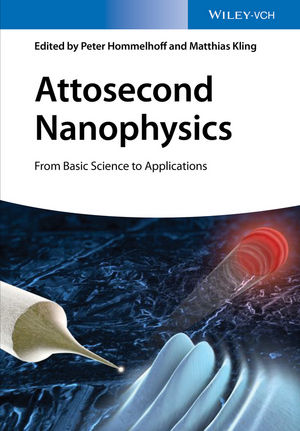The knowledge of ultrafast electrons in solids

A steadily growing treasure of knowledge has accumulated in the past years on attosecond nanophysics of nanostructured solids, which has, so far, not been sorted and structured. This has now been rectified by two physics professors, Peter Hommelhoff and Matthias Kling.
Together with numerous other authors, they have collected the studies conducted in this very young science field in their book “attosecond nanophysics”. The result is an overview for PhD students and interested students as well as other physicists, who like to gain an overview of ultrafast nanooptics and related fields.
Elementary particles interacting with light move so fast, that they can only be observed with the help of sophisticated techniques. Typically, the motion of excited electrons in atoms or solids, for example, occurs on attosecond timescales. An attosecond is a billionth of a billionth of a second (10^-18 s).
Starting a few years ago, scientists around the world have been exploring how electrons in nanostructured solids behave when influenced by extremely short and intense light pulses. In order to observe such rapid electron motion, physicists used light pulses with durations of a few femtoseconds down to attoseconds (a femtosecond lasts 1000 attoseconds).
These light flashes act, for example, as an ultrafast shutter, following the principles of conventional camera technology, to take pictures of the fast moving particles in the nanocosm.
The researchers’ new book is a collection of their accumulated knowledge in this new research area, a first publication of its kind. The main attention here is not drawn to single atoms or molecules but rather to nanostructured solids, which are typically comprised of many millions of atoms. The main question is: how do electrons behave under the influence of intense light?
The answer to this question is of fundamental importance. This research could lead to new technologies, where the electromagnetic field of the light wave can be used to carefully control minute electronic building blocks. With such lightwave-controlled electronics, switching speeds in the petahertz domain (10^15 Hz, one million times a billion operations per second) may be reached. “With this technology we could accelerate current electronics by up to a million times”, explains Matthias Kling, one of the editors of the book.
“Attosecond nanophysics” contains the descriptions of experiments which have been conducted in the last years and resulted in groundbreaking scientific publications. The book also contains their mathematical and physical foundations. “All authors are pioneers in this field”, describes the second editor, Peter Hommelhoff.
“We have compiled – for the first time – a book, which conveys a current overview of our knowledge and activities on currently the fastest phenomena in the area of small solids”, elaborates Hommelhoff. With this the authors provide students of upper level physics and PhD students a handy overview of the topic. But also interested colleagues from other disciplines can use this book to gain a first, comprehensive insight into this young field of attosecond nanophysics.
publication:
Peter Hommelhoff, Matthias Kling: Attosecond Nanophysics: From Basic Science to Applications.Wiley-VCH, Berlin 2015, 392 pages, ISBN: 978-3-527-41171-9
Media Contact
All latest news from the category: Physics and Astronomy
This area deals with the fundamental laws and building blocks of nature and how they interact, the properties and the behavior of matter, and research into space and time and their structures.
innovations-report provides in-depth reports and articles on subjects such as astrophysics, laser technologies, nuclear, quantum, particle and solid-state physics, nanotechnologies, planetary research and findings (Mars, Venus) and developments related to the Hubble Telescope.
Newest articles

Trotting robots reveal emergence of animal gait transitions
A four-legged robot trained with machine learning by EPFL researchers has learned to avoid falls by spontaneously switching between walking, trotting, and pronking – a milestone for roboticists as well…

Innovation promises to prevent power pole-top fires
Engineers in Australia have found a new way to make power-pole insulators resistant to fire and electrical sparking, promising to prevent dangerous pole-top fires and reduce blackouts. Pole-top fires pose…

Possible alternative to antibiotics produced by bacteria
Antibacterial substance from staphylococci discovered with new mechanism of action against natural competitors. Many bacteria produce substances to gain an advantage over competitors in their highly competitive natural environment. Researchers…





















